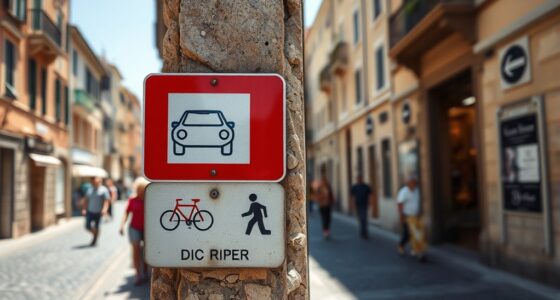Exploring Italy’s lesser-known UNESCO World Heritage Sites lets you discover hidden cultural treasures that go beyond famous landmarks. You’ll experience unique traditions, historic towns, and authentic regional cuisines that showcase Italy’s rich diversity. These sites reveal Italy’s deep-rooted history and craftsmanship, offering immersive, meaningful experiences that connect you to local communities. Keep discovering these secrets to truly appreciate Italy’s extraordinary heritage and the efforts to preserve it for future generations.
Key Takeaways
- Discover Italy’s rich heritage beyond famous landmarks through UNESCO-listed sites like Civita di Bagnoregio and Val d’Orcia.
- Learn about local preservation efforts that maintain authentic architecture, crafts, and culinary traditions.
- Experience immersive cultural and culinary practices rooted in regional history and craftsmanship.
- Support sustainable tourism that helps protect and sustain lesser-known historical sites and community livelihoods.
- Appreciate the diversity of Italy’s cultural landscape, showcasing unique histories, arts, and regional identities.

Have you ever wondered what makes Italy a treasure trove of cultural and historical wonders? It’s not just the famous landmarks like the Colosseum or Venice’s canals, but also the lesser-known UNESCO sites that reveal the country’s rich and diverse heritage. These hidden gems often showcase unique aspects of Italy’s history, art, and traditions, offering a deeper understanding of the nation’s identity. Visiting these sites allows you to immerse yourself in local culinary traditions, which are deeply rooted in regional history and culture. Many of these areas have preserved ancient recipes and cooking techniques, giving you a taste of Italy’s culinary diversity beyond the well-trodden tourist paths. As you explore, you’ll notice that local communities value their heritage, actively engaging in historical preservation efforts to maintain their sites’ authenticity and charm. These efforts ensure that future generations can appreciate the cultural significance embedded in every stone and street corner.
One such lesser-known UNESCO site is the town of Civita di Bagnoregio, perched atop a hill in Lazio. Its dramatic landscape and well-preserved medieval architecture make it a *fascinating* destination. Here, local culinary traditions thrive, with dishes passed down through generations, often involving simple ingredients like locally grown vegetables, olive oil, and hearty bread. The community’s dedication to preserving its history is evident in the meticulous restoration of ancient structures and the promotion of traditional crafts. By supporting local businesses and eateries, you help sustain these preservation efforts, ensuring the town’s stories continue to resonate. Additionally, the preservation of architectural heritage plays a crucial role in maintaining the town’s unique charm and historical significance.
Another hidden treasure is the Val d’Orcia in Tuscany, a breathtaking scenic landscape dotted with medieval towns, terraced vineyards, and farmhouses. This region’s recognition as a UNESCO site highlights its cultural significance, but it’s also a *proof* of ongoing historical preservation efforts. Local artisans and farmers maintain age-old techniques, from crafting traditional pottery to producing authentic Pecorino cheese. Sampling these products not only offers a delicious experience but also connects you to the region’s history and its commitment to sustainability. Walking through the rolling hills and small villages, you’ll observe how the community’s dedication to preserving their heritage sustains their way of life and keeps their traditions alive.
In exploring Italy’s lesser-known UNESCO sites, you uncover stories that go beyond the typical tourist attractions. You see how local communities actively work to preserve their history, culture, and culinary traditions, making each visit a meaningful journey. These sites remind you that Italy’s true charm lies in its ability to blend the past with the present, offering authentic experiences rooted in centuries of tradition. By appreciating and supporting these efforts, you contribute to the ongoing preservation of Italy’s extraordinary cultural landscape.
Frequently Asked Questions
Are There Guided Tours Available at Lesser-Known UNESCO Sites?
Yes, guided tours are available at lesser-known UNESCO sites in Italy. You can find these tours through local visitor information centers, tour operators, or online booking platforms. They offer insightful commentary, enhance your understanding of the site’s history, and often include access to areas off-limits to solo visitors. Booking in advance is recommended to secure your spot and make certain you get the most out of your experience at these hidden gems.
How Accessible Are These Sites for Disabled Visitors?
Accessibility at these sites is like traversing a well-paved path; many offer mobility assistance and wheelchair accessibility, making exploration easier. You’ll find ramps, accessible restrooms, and helpful staff ready to support your visit. While some sites might have uneven terrain, many are committed to improving accessibility. Always check in advance to guarantee the specific site meets your needs, and enjoy discovering Italy’s hidden treasures comfortably and confidently.
What Are the Best Times of Year to Visit These Hidden Gems?
The best seasons to visit Italy’s lesser-known UNESCO sites are spring and fall when the weather is ideal—mild, pleasant, and less crowded. Spring brings blooming landscapes, while fall offers comfortable temperatures and fewer tourists. Summer can be hot and busy, and winter might limit access to some sites. Visiting during these ideal weather seasons guarantees you enjoy the hidden gems comfortably and without the peak-season crowds.
Are There Local Accommodations Near These UNESCO Sites?
Yes, you’ll find plenty of local lodging options near these UNESCO sites. Nearby inns and cozy bed-and-breakfasts give you an authentic Italian experience while staying close to the attractions. Many are family-run, offering personalized service and delicious local cuisine. Booking in advance guarantees you secure the best accommodations, and staying nearby allows you to explore these hidden gems at your own pace without long travel times.
What Local Customs Should Visitors Respect When Exploring These Sites?
When exploring these sites, you should follow etiquette tips like speaking softly and avoiding loud behavior to respect the tranquility. Be mindful of cultural sensitivities, such as dressing modestly and refraining from touching artifacts. Always ask for permission before photographing locals or their property. By showing respect for local customs, you help maintain these UNESCO sites’ integrity and ensure a positive experience for everyone.
Conclusion
As you venture beyond the familiar, you’ll find Italy’s hidden UNESCO treasures waiting to be discovered. These lesser-known sites showcase Italy’s rich history, stunning scenery, and unique stories, sparking your curiosity and deepening your devotion. Embrace the allure of these alluring, authentic attractions, and let their mystery-mantled marvels mesmerize your mind. By exploring these hidden havens, you’ll uncover Italy’s incredible, intricate identity, inspiring your imagination and igniting your love for its lesser-known legacy.









